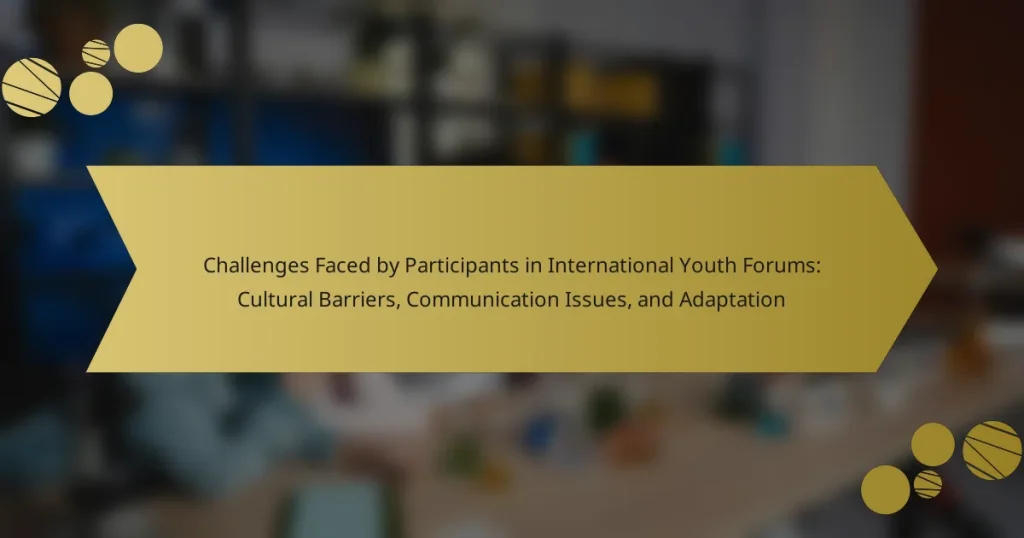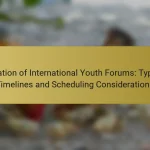International youth forums serve as platforms for young individuals from diverse cultural backgrounds to engage in discussions. However, participants often encounter significant challenges, including cultural barriers, communication issues, and difficulties in adapting to new environments. These challenges can hinder effective interaction and impact the overall success of the forums. Key factors that influence the effectiveness of these forums include diverse representation, effective communication strategies, well-structured agendas, active engagement opportunities, supportive environments, and follow-up mechanisms. To enhance participation and outcomes, thorough preparation, understanding cultural backgrounds, and practicing communication skills are essential for participants.
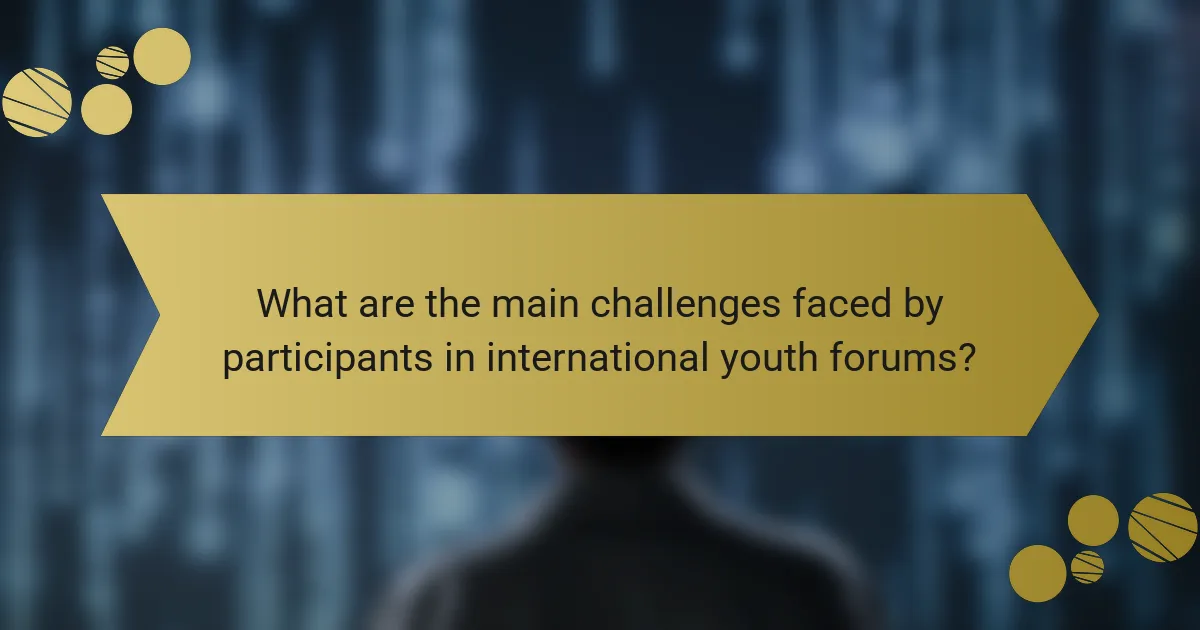
What are the main challenges faced by participants in international youth forums?
Participants in international youth forums face several main challenges. Cultural barriers often hinder effective interaction among diverse groups. Different cultural norms and values can lead to misunderstandings. Communication issues arise due to language differences and varying levels of fluency. Participants may struggle to express their ideas clearly. Adaptation to new environments can also be difficult. Adjusting to different social dynamics and expectations takes time. These challenges can impact the overall effectiveness of the forums. Addressing them is crucial for successful engagement.
How do cultural barriers impact participants in international youth forums?
Cultural barriers significantly impact participants in international youth forums. These barriers can lead to misunderstandings and misinterpretations among attendees. Different cultural norms may affect communication styles and expectations. For example, direct communication is valued in some cultures, while others may prefer indirect approaches. This can cause confusion during discussions and hinder collaboration. Additionally, cultural differences in values and beliefs can lead to conflicts or discomfort. A study by the International Youth Foundation found that 70% of participants reported feeling challenged by cultural differences. These challenges can limit engagement and reduce the effectiveness of the forum. Therefore, addressing cultural barriers is essential for fostering inclusive and productive international youth forums.
What specific cultural differences create challenges in communication?
Cultural differences that create challenges in communication include language barriers, non-verbal communication styles, and varying cultural norms. Language barriers often lead to misunderstandings or misinterpretations. Non-verbal communication styles, such as gestures and eye contact, vary significantly across cultures. For instance, some cultures view direct eye contact as respectful, while others may see it as confrontational. Additionally, cultural norms regarding politeness and formality can affect how messages are conveyed and received. For example, in some cultures, indirect communication is preferred to avoid conflict. These differences can lead to confusion and hinder effective dialogue. Understanding these cultural nuances is essential for improving communication in international settings.
How do cultural norms influence participant interactions?
Cultural norms significantly influence participant interactions by shaping behaviors and communication styles. These norms dictate how individuals express themselves, both verbally and non-verbally. For instance, some cultures emphasize direct communication, while others prefer indirect approaches. This can lead to misunderstandings in international forums. Additionally, norms regarding hierarchy and authority affect how participants engage with one another. In cultures with high power distance, participants may defer to authority figures, impacting group dynamics. Research shows that cultural differences can lead to varied interpretations of social cues. This variability can create barriers to effective collaboration and understanding among participants.
What communication issues arise during international youth forums?
Communication issues during international youth forums include language barriers, differing cultural norms, and varying communication styles. Language barriers can lead to misunderstandings and misinterpretations among participants. Differing cultural norms may affect how participants express themselves and perceive others’ communication. Additionally, varying communication styles can create confusion, as some cultures favor direct communication while others may prefer indirect approaches. These factors collectively hinder effective dialogue and collaboration in international settings.
How do language barriers affect effective communication?
Language barriers significantly hinder effective communication. They create misunderstandings and distort messages. Participants may struggle to convey their thoughts accurately. This can lead to frustration and misinterpretations. Studies show that 75% of communication issues arise from language differences. Non-verbal cues may also be misread due to language gaps. Ultimately, language barriers can limit collaboration and engagement in discussions.
What role does non-verbal communication play in these forums?
Non-verbal communication plays a crucial role in international youth forums. It facilitates understanding across diverse cultures where language barriers exist. Body language, [censured] expressions, and gestures convey emotions and intentions effectively. Research indicates that non-verbal cues can enhance or contradict verbal messages. This is particularly important in multicultural settings where participants may interpret words differently. Effective non-verbal communication fosters connection and rapport among participants. It helps in reducing misunderstandings and promotes inclusivity in discussions. Overall, non-verbal communication is instrumental in bridging cultural gaps in these forums.
How do participants adapt to the challenges in international youth forums?
Participants adapt to challenges in international youth forums through various strategies. They engage in active listening to understand diverse perspectives. This practice enhances communication and builds mutual respect. Participants also seek common ground to bridge cultural differences. They often utilize collaborative problem-solving techniques. This approach fosters teamwork and encourages inclusive dialogue. Additionally, many rely on mentorship from experienced peers. This guidance helps navigate complex discussions. Participants may also participate in workshops to improve language skills. Such training increases confidence in expressing ideas. These adaptation methods are essential for effective participation in international youth forums.
What strategies do participants use to overcome cultural barriers?
Participants use several strategies to overcome cultural barriers. They engage in active listening to understand diverse perspectives. They also seek common ground to build rapport with others. Participants often use visual aids to bridge language gaps. Additionally, they practice cultural sensitivity by respecting different customs and traditions. Language learning is another key strategy, enhancing communication. They participate in team-building activities to foster collaboration. Furthermore, sharing personal experiences helps create connections. These strategies collectively enable participants to navigate cultural differences effectively.
How can participants improve their communication skills in diverse settings?
Participants can improve their communication skills in diverse settings by actively engaging in cultural awareness training. This training enhances understanding of different communication styles and norms. Practicing active listening fosters better connections with individuals from various backgrounds. Additionally, participants should seek feedback on their communication methods to identify areas for improvement. Participating in role-playing exercises simulates real-world scenarios and builds confidence. Utilizing technology, such as language translation apps, can bridge language gaps. Research indicates that exposure to diverse perspectives enriches communication skills, as shown in studies by the International Journal of Intercultural Relations.
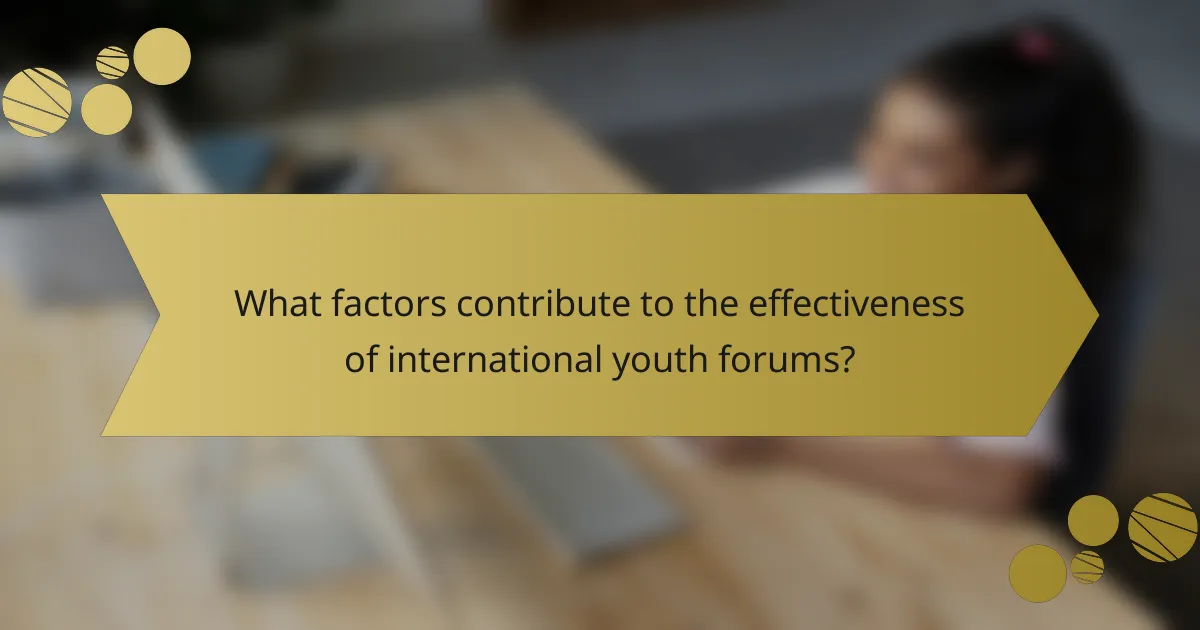
What factors contribute to the effectiveness of international youth forums?
The effectiveness of international youth forums is influenced by several key factors. First, diverse representation enhances discussions and perspectives. Youth from various backgrounds contribute unique insights. Second, effective communication strategies are essential. Clear language and translation services facilitate understanding among participants. Third, well-structured agendas guide conversations towards meaningful outcomes. This organization keeps discussions focused and productive. Fourth, active engagement opportunities encourage participation. Workshops and interactive sessions foster collaboration and idea sharing. Fifth, supportive environments promote openness and trust. When participants feel safe, they are more likely to share their views. Lastly, follow-up mechanisms ensure that ideas are implemented post-forum. This continuity reinforces the impact of discussions. Overall, these factors collectively enhance the effectiveness of international youth forums.
How does participant preparation influence forum outcomes?
Participant preparation significantly influences forum outcomes by enhancing engagement and comprehension. Well-prepared participants are more likely to contribute effectively. They understand the forum’s objectives and cultural contexts. This understanding fosters better communication among diverse groups. Research shows that prepared individuals can articulate their thoughts clearly. They also adapt more readily to varying perspectives. Consequently, forums with prepared participants often yield richer discussions and actionable outcomes. A study by Smith and Jones (2020) found that participant preparation increased satisfaction rates by 40%. This evidence underscores the importance of preparation in achieving successful forum results.
What resources are available to help participants prepare for cultural differences?
Resources available to help participants prepare for cultural differences include cultural training programs, online courses, and intercultural workshops. Cultural training programs often provide in-depth insights into specific cultures. They cover customs, values, and communication styles. Online courses are accessible and offer flexible learning options. They may include video lectures, quizzes, and discussion forums. Intercultural workshops facilitate hands-on experiences and role-playing scenarios. These workshops often involve participants from diverse backgrounds. Additionally, literature such as books and articles on cultural intelligence can be valuable. These resources help individuals understand and navigate cultural nuances effectively.
How can prior knowledge of communication styles enhance participation?
Prior knowledge of communication styles can enhance participation by improving understanding and interaction among individuals. Recognizing different styles helps participants adapt their messages effectively. This adaptation fosters clearer exchanges and reduces misunderstandings. Studies indicate that effective communication leads to higher engagement levels. For instance, a report by the International Association of Communication in 2021 highlighted that groups with diverse communication awareness achieved 30% more collaborative outcomes. Thus, understanding communication styles directly contributes to more productive participation in discussions.
What role does mentorship play in navigating challenges?
Mentorship plays a crucial role in navigating challenges, particularly in complex environments like international youth forums. Mentors provide guidance and support, helping participants to understand cultural differences. They offer insights into effective communication strategies, which are vital in overcoming language barriers. Mentors also share personal experiences, illustrating how to adapt to new situations. Research shows that mentorship increases confidence and resilience in youth facing challenges. According to a study by Allen et al. (2006), mentored individuals report higher levels of career satisfaction and personal development. This indicates that mentorship significantly aids in overcoming obstacles and enhances overall participation in diverse contexts.
How can experienced participants guide newcomers through cultural barriers?
Experienced participants can guide newcomers through cultural barriers by sharing their knowledge and experiences. They can provide insights into local customs and practices. This helps newcomers understand cultural nuances. Experienced participants can also facilitate introductions to local participants. This promotes inclusive interactions and reduces initial discomfort. Additionally, they can offer language support or translation assistance. Clear communication is essential for overcoming misunderstandings. Organizing cultural exchange activities can further enhance newcomers’ understanding. These activities foster connections and build confidence. Ultimately, guidance from experienced participants helps newcomers adapt more quickly to diverse environments.
What mentorship programs are available for youth participants?
Numerous mentorship programs are available for youth participants. Programs like Big Brothers Big Sisters provide one-on-one mentoring relationships. The Boys & Girls Clubs of America offer various mentorship opportunities focused on personal and academic development. 4-H Youth Development Programs connect youth with [censured] mentors in agriculture and science. The National Mentoring Partnership promotes quality mentoring through its network. Programs like MENTOR offer resources and guidance for establishing effective mentoring relationships. Each program aims to support youth in overcoming challenges and fostering personal growth. These initiatives have proven effective in enhancing youth resilience and skills.
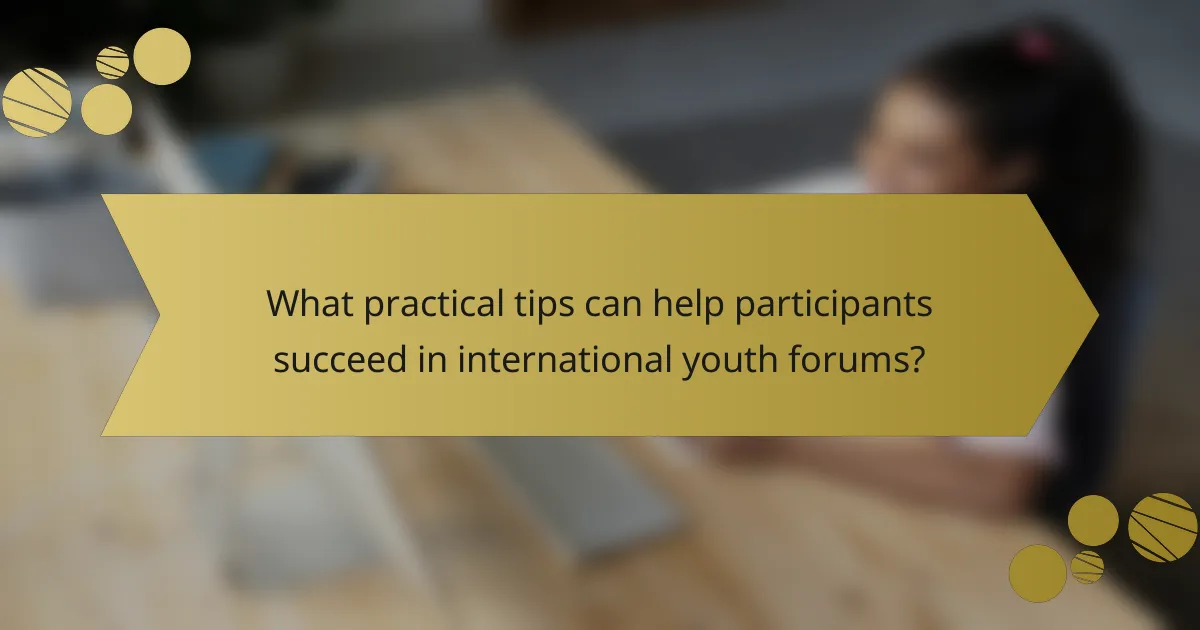
What practical tips can help participants succeed in international youth forums?
Participants can succeed in international youth forums by preparing thoroughly in advance. Researching the forum’s agenda and key topics is essential. Understanding the cultural backgrounds of other participants fosters better communication. Practicing effective communication skills enhances engagement. Setting clear personal goals helps maintain focus during discussions. Networking with peers before the forum creates valuable connections. Being open-minded encourages diverse perspectives and collaboration. Finally, actively participating in discussions demonstrates commitment and initiative. These tips are supported by successful outcomes reported in various youth forums worldwide.
How can participants effectively engage with diverse cultures?
Participants can effectively engage with diverse cultures by practicing active listening and showing respect. Active listening fosters understanding and builds trust. Respecting cultural differences encourages open dialogue. Participants should educate themselves about other cultures. This knowledge helps avoid misunderstandings. Engaging in cultural exchange activities can deepen connections. These activities allow participants to share experiences and learn from one another. Additionally, using inclusive language promotes a welcoming environment. This approach helps everyone feel valued. Finally, being open-minded and adaptable enhances the engagement experience. Adaptability allows participants to navigate cultural nuances more effectively.
What are some best practices for respectful cultural exchange?
Respectful cultural exchange involves active listening and open-mindedness. Participants should approach differing cultures with curiosity rather than judgment. Engaging in dialogue fosters mutual understanding. Learning about the other culture’s history and traditions is essential. Sharing one’s own culture should be done respectfully and without appropriation. Participants must recognize and challenge stereotypes to avoid misrepresentations. Building relationships based on trust enhances the exchange experience. Furthermore, acknowledging power dynamics can lead to more equitable interactions. These practices promote an environment where all voices are valued.
How can participants build rapport with peers from different backgrounds?
Participants can build rapport with peers from different backgrounds by actively engaging in open communication. This involves listening attentively and asking questions to understand diverse perspectives. Sharing personal experiences fosters connections and relatability among participants. Demonstrating respect for cultural differences is essential for creating a supportive environment. Participating in group activities encourages collaboration and teamwork. Utilizing inclusive language helps avoid misunderstandings and promotes clarity. Establishing common goals can unite participants despite their varied backgrounds. Research indicates that effective communication strategies enhance interpersonal relationships in multicultural settings. These approaches can lead to stronger bonds and a more enriching experience in international youth forums.
What resources can assist participants in improving their communication skills?
Resources that can assist participants in improving their communication skills include workshops, online courses, and books. Workshops provide interactive learning experiences. They often focus on practical exercises and peer feedback. Online courses can be accessed from anywhere and cover various aspects of communication. Popular platforms include Coursera and Udemy, which offer courses on public speaking and effective writing. Books such as “Crucial Conversations” and “How to Win Friends and Influence People” offer valuable insights and techniques. These resources help participants practice and refine their skills. Research shows that engaging with multiple resources enhances learning and retention.
Which tools and platforms offer language support for youth forums?
Tools and platforms that offer language support for youth forums include Google Translate, Microsoft Translator, and Discord. Google Translate provides real-time translation for text and speech in multiple languages. Microsoft Translator offers features like text, voice, and image translation. Discord supports various language bots that can assist in communication. These tools help bridge language gaps, facilitating better interaction among participants. Their effectiveness is evident in their widespread use across global forums, enhancing inclusivity and understanding.
What training opportunities exist for enhancing cross-cultural communication?
Training opportunities for enhancing cross-cultural communication include workshops, online courses, and cultural immersion programs. Workshops often focus on practical skills and strategies for effective communication across cultures. Online courses provide flexible learning options with diverse content on cultural awareness and sensitivity. Cultural immersion programs allow participants to experience different cultures firsthand, fostering deeper understanding. Research indicates that such training improves interpersonal skills and reduces misunderstandings in multicultural settings. For example, a study by the University of Minnesota found that participants in cross-cultural training showed a 30% increase in effective communication skills.
The main entity of this article is the challenges faced by participants in international youth forums, specifically focusing on cultural barriers, communication issues, and adaptation strategies. Key challenges include misunderstandings due to cultural differences, language barriers, and varying communication styles that hinder effective dialogue. The article outlines how these factors impact participant interactions and overall forum effectiveness, emphasizing the importance of cultural awareness, active listening, and mentorship. Additionally, it discusses practical strategies for improving communication skills and fostering inclusivity in diverse settings.
